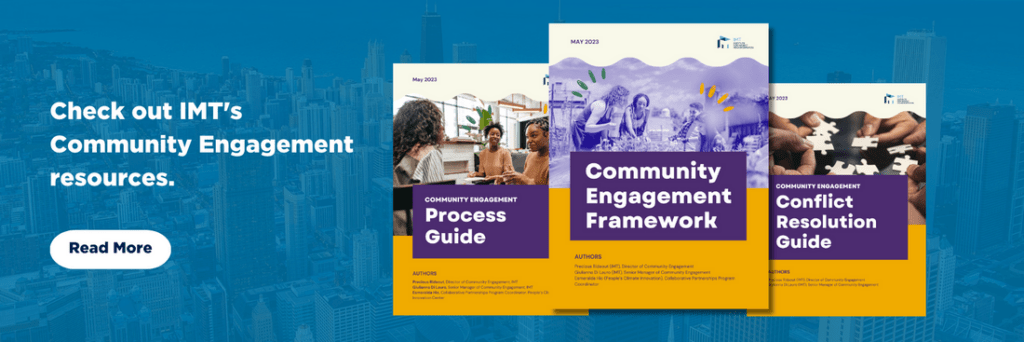
In Part 1, we covered the unintended harms that are frequently mentioned when IMT collaborates with community-based organizations and local governments. Let’s get into the potential solutions!
Addressing these concerns requires a holistic approach that includes financial support, equitable community engagement, affordable housing protections, green workforce development, health impact assessments, and cultural sensitivity. From my work, the following proposals are applicable to most communities affected by and engaging in decarbonization. Still, partners that are involved in these solutions, especially more powerful entities like government and utilities, should follow community leadership to tackle their unique issues.
Community Engagement and Decision-Making
Involving frontline and BIPOC communities in the decision-making process is a first step, with the ultimate goal being ownership of climate solutions by frontline communities. Community engagement ensures that the transition efforts address their specific needs and concerns, empowering them to decide the changes that affect their lives and neighborhoods.
- Utilizing Community Strengths: Community-based organizations (CBO) and frontline community members likely have their own formations in place. For example, there may already be community-based groups meeting and organizing around the climate crisis and potential solutions. These groups should be recognized, funded, and supported to work with cities and other jurisdictions rather than local governments creating their own task force that in essence, replicate the group’s work. Governments should always consider community strengths when embarking on community work. For example, if a city wants to conduct focus groups, or surveys in the community, instead of hiring a contractor or doing it themselves, they could work with (and resource) CBOs that have already built trust in the community to have these conversations and administer surveys.
- Community Accountability Boards (CAB): If there are no community formations in place, establish empowered community task forces made up of representatives from frontline communities and BIPOC populations. These task forces can work alongside policymakers and organizations to provide valuable insights, feedback, and recommendations on electrification and decarbonization initiatives. An example of this is the city of Boston’s Review Board.
- Logistic Flexibility for Community Input: Many regulatory decisions occur during business hours. Unless there is a CBO with specific funds and/or capacity dedicated to building decarbonization, the ability for community input is minimal. Recorded, publicly accessible meetings or meetings that occur after business hours can increase community engagement in decision making. Also consider the different communities’ language and accessibility needs, and provide translation, child care, and accommodations for disabilities.
- Participatory Budgeting (PB): is a democratic process empowering community members to actively determine the allocation of a portion of the public budget. This approach grants everyday individuals influence over tangible financial resources, facilitating collaborative decision-making with governmental bodies to shape budgetary choices. Specific taxes, and money generated from a Building Performance Standard (BPS) could be set aside for community members to develop and fund solutions that address the issues they’re facing in their communities.
Equitable Funding and Subsidies
Governments and organizations can allocate funds specifically to support electrification and decarbonization efforts in frontline communities and for BIPOC households. Targeted subsidies and financial assistance can help alleviate the energy cost burden and make clean energy technologies more accessible.
- Targeted Financial Assistance: Governments and organizations can provide targeted financial assistance and grants to help low-income households in these communities access renewable energy solutions, such as solar panels or heat pumps. These financial aids should prioritize those who may struggle to afford upfront costs.
- Income-Based Subsidies: Introduce income-based subsidy programs that adjust incentives based on income levels. This ensures that those with lower incomes receive more substantial support, helping to alleviate the energy cost burden for vulnerable households.
- Public Financing: Enable mission-based affordable housing providers to safeguard existing affordable housing stock and develop new units through accessible public financing. This approach will not only shield tenants and mission-based, 100% affordable housing providers from the adverse impacts of gentrification (such as displacement, escalating rents, and mounting maintenance expenses), but also foster sustainable and environmentally responsible housing solutions.
If similar programs already exist in your jurisdiction, consider new ways to survey the communities the programs were designed for to gain feedback on the programs’ impact and relevance to addressing their needs.
Affordable Housing Protections
Implementing policies to protect affordable housing and prevent displacement is essential. Rent control measures and affordable housing programs can help ensure that long-time residents can continue to live in their communities despite rising property values.
- Map Housing Stock: Create a comprehensive mapping of affordable housing stock within cities/jurisdictions, categorizing them based on energy performance and distinguishing between properties owned and/or operated by mission-based, 100% affordable housing developers versus corporate landlords and investment entities. The map should provide insights into:
- where affordable housing is located,
- current building conditions,
- energy efficiency ratings,
- how to preserve existing affordable housing and generate new stock, and
- the impact of systemic harms such as redlining and racially biased planning and zoning policies on community health outcomes.
- Rent Control Measures: Implement rent control policies to regulate and limit rent increases in areas undergoing electrification and decarbonization. This helps protect tenants from exorbitant price hikes and prevents forced evictions. Some examples include:
- Oregon: In 2019, Oregon signed into law the first statewide rent control bill in the United States (SB 608). The bill does two things: a rental increase cap and a tightening of rules for evictions. Landlords are prohibited from raising the rent more than 7% plus inflation annually, and renters can’t be evicted without cause after a year of tenancy at their apartment. Substantial renovations are considered a cause for eviction and under this circumstance, the landlord must pay the tenant a relocation assistance fee (usually one month’s rent).
- California: In 2020, California passed a similar statewide rent control bill (AB 1482). The law restricts the allowable annual rent increase to 5% plus a local cost-of-living adjustment of no more than 5%, for a maximum increase of 10%. Substantial renovations are considered a cause for eviction and under this circumstance, the landlord must pay the tenant a relocation assistance fee equal to one month’s rent.
- Vienna, Austria: Vienna’s approach to housing has been recognized as a model for other cities and countries around the world. Renowned for its comprehensive social housing policies, the city owns around 220,000 rental apartments, making up a significant portion of the housing stock. In the second quarter of 2022, the monthly average rent including running costs in Austria was €574.3 ($623.17 at present time) per dwelling per month, or €8.6 per square meter. Rent increases for these apartments are strictly regulated and are typically tied to the cost of living index. Vienna also prioritizes social integration in its housing policies. Municipal housing is made up of mixed income residents. This approach aims to promote social integration and avoid the concentration of poverty in certain neighborhoods.
- Affordable Housing Requirements: Introduce requirements or incentives for developers to include affordable housing units in new construction projects. This ensures that a portion of the housing stock remains affordable for low-income residents amidst neighborhood transformations.
- Ban decarbonization pass-through costs: Categorize decarbonization retrofits (water and energy efficiency measures) as “ineligible costs” under cities’ Primary Renovation Programs or Capital Improvements Programs.
- Offer mission-based affordable housing providers an alternative compliance route: Incorporate a customized alternative compliance path within any building performance policy, specifically tailored to mission-based, 100% affordable housing providers. The adjustments to this compliance path should be developed collaboratively with affordable housing stakeholders, potentially involving modified targets based on baseline performance, extended compliance timelines, or prescriptive compliance pathways that expedite reimbursements for upfront expenses.

Green Workforce Development
Governments and organizations can invest in workforce development programs that focus on training and hiring from frontline and BIPOC communities. This helps create a more diverse and inclusive green workforce, providing opportunities for those who may face barriers to traditional job markets.
- Targeted Job Training: Develop targeted job training programs that focus on building skills for renewable energy technologies, energy efficiency, and other sustainable industries. These programs should actively recruit participants from frontline and BIPOC communities to create a diverse and inclusive green workforce.
- Workforce Partnerships: Collaborate with local community organizations and trade unions to create pathways for underrepresented groups to access green jobs. Partnering with established entities can strengthen networking opportunities and increase job placement rates.
Health Impact Assessments
Before implementing large-scale electrification and decarbonization projects, health impact assessments can identify potential risks and create plans to mitigate air quality issues during construction and retrofitting phases.
- Preventive Measures: Conduct health impact assessments before initiating large-scale electrification projects. These assessments can identify potential health risks and allow for the implementation of preventive measures to mitigate air pollution during construction and exposure to hazardous materials during retrofits.
- Community Health Programs: Develop community health programs that offer support and resources to address any health issues resulting from construction / retrofit activities. These programs can be developed by city governments, in partnership with CBOs and non profits, and can include access to healthcare services, outdoor / indoor air quality monitoring, and health education.
Cultural Sensitivity
Policymakers and organizations should work closely with communities to understand their cultural practices and values. Integrating cultural considerations into the planning and implementation of sustainability initiatives can foster greater acceptance and cooperation.
- Tailored Solutions: Work with communities to develop tailored electrification and decarbonization solutions that align with their cultural practices and values. Emphasize community-based approaches that empower residents to take an active role in shaping their sustainable future.
Tribal Inclusion & Leadership in Decarbonization Efforts
Policy makers, code writers, private and public utility leaders must restructure decision-making protocols to include tribes. A note on capacity: most tribes do not have a dedicated FTE (Full Time Equivalent) for decarbonization or do not have the technical expertise to participate in energy decisions. Creating a participation structure that is low commitment, and/or specifically compensates tribal personnel can remedy capacity constraints in tribal nations. Regulatory entities requesting tribal participation need to explicitly state that participation does NOT waive tribal sovereignty regardless of compensation (NREL).
- Codes: Green building codes do not apply on tribal lands. Tribal inclusion in energy efficiency code measures can strengthen government-to-government relations by sharing knowledge and technologies toward decarbonization (EPA).
- Utility: Except in California, no state has a tribal consultation policy for public utilities. Increasing tribal consultation requirements prior to public utility decisions can promote awareness of and impact to renewable resources on tribal lands. (Testimony of Pilar Thomas to House of reps)
- Policy: Regulatory entities should establish a tribal liaison position to facilitate tribes navigating the large, complex regulatory hierarchy. Tribal participation is more likely when a dedicated person has the time and knowledge to address the specific needs of tribes.
Community members know and hold the solutions for the challenges they are facing, especially when it comes to the climate crisis. The information outlined in this article is not a substitute for deep and authentic engagement, and I hope that this can serve as a foundation and push for readers to start, continue, or re-commit to prioritizing community leadership.
